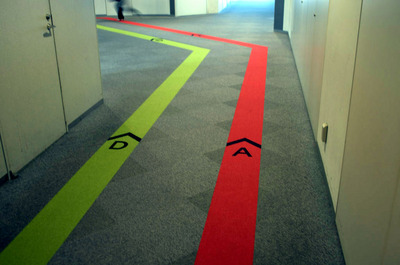 Last week I visited an interesting presentation at Harvard’s Urban Mobilities Group. They had invited Austrian cartographer Georg Gartner who gave a talk about his ‘semantic wayfinding‘ project.
Last week I visited an interesting presentation at Harvard’s Urban Mobilities Group. They had invited Austrian cartographer Georg Gartner who gave a talk about his ‘semantic wayfinding‘ project.
Semantic wayfinding is an approach to navigation media that takes human thinking, language and action as a starting point for the design of wayfinding technology and mapping interfaces.
The main goal of SemWay is to develop a methodology and models giving answers to the question how the process of human wayfinding can be supported by semantically enriched navigation systems in order to provide a meaningful interaction between wayfinders and the surrounding spatial environment.
Natural language
Right now most navigation software uses formal descriptions of space, but that is not how humans deal with their surroundings. For instance rather than drafting up a long list of formal instructions like ‘Follow the hallway for 20 meters, take a right turn, take the elevator down, pass the concierge desk, etc’, for most people the instruction ‘leave the building’ will be more than enough information – it will even be perceived as a much clearer instruction. Part of the research of Gartner’s group is focused on every day life descriptions people use to navigate through space. This way they hope to build up a taxonomy of ‘natural language’ that can be used in instructions.
Subjective landmarks
A second point is the inclusion of subjective landmarks. Wayfinding often refers to objective landmarks, clearly recognizable objects in space. Again, that’s not the way most people think of their city. Gartner: ‘Imagine a street in which all houses look exactly alike, but your girlfriend lives in one of those houses, than that is a landmark as well. Or if I get pickpocketed in a certain place, I will remember that place for ever.’ These subjective landmarks could be much more powerful for giving wayfinding instructions. This seems a promising approach, but it also brings up a lot of ethical issues. Do you want to be remembered of being pickpocketed at a certain place by your navigation software? And how would your navigation device know the subtle but important difference between let’s say a girlfriend and a mistress? What if the device refers to your girlfriend’s/mistresses’ house when your wife is in the car as well?
Behavioral context
Behavioral context is also an important factor that should be included in wayfinding, Gartner argues. For instance, there is a relation between maps and mode of transportation. Someone who is driving at high speeds needs a different interface to the geographic data than someone who is walking through the same area. A driver generally does not have much time to take a decision, so you don’t want his interface to be too cluttered. A pedestrian approaches the city from a different perspective, and has different needs. So how does that translate to a different grammar in mapping and locational services?
modalities or urban use
Similarly, there are also different ‘modes’ in which people use the city. One day you’ll just want to get somewhere as fast as possible, at another time you might be out for a recreational stroll. Obviously that ask for different routes and different kinds of contextual information. Can this type of contextual behavior be included in wayfinding algorithms?
Research done at Gartner’s faculty also shows that there is a clear correlation between certain demographic / lifestyle clusters and use of space. Researchers analyzed the spatial behavior of a group of people in a shopping mall in Vienna, and found very diverse results. One cluster of ‘users’ (mostly male and under 30) walks twice as fast as people in other clusters and hardly takes any breaks. Whereas another cluster (mostly female aged 30-35) doesn’t only walk slower, but also pauses more often. Now can information like this be used in algorithms in wayfinding devices? Would it be helpful? Or could it lead to awkward situations, similar to a spatial equivalent of obviously mistargeted Google ads showing up in your web browser, when somehow the algorithm erroneously ‘thinks’ that your pregnant or suffer from some kind of disease.
Semantic wayfinding and mental maps
So obviously, there are some issues to be figured out, but I think semantic wayfinding is a promising development. Gartner himselfs hopes that it might help overcome the ‘keyhole’ problem of current navigational interfaces. His research shows that people who use small screen navigation devices (for instance on the mobile phone) have a much harder time to make up correct mental maps of their environments than people who use old fashioned paper maps.
Part of the problem is that navigation software tends to make their users passive. If you follow the instructions of your navigation device, you often stop making a mental map all together. So when the software fails or crashes, people usually have no idea where they are.
The second problem is that the on screen maps are usually very small. Gartner compares this to looking at a scene through a keyhole. You cannot take in the whole scene at once, but have to mentally stitch the different fragments together. Gartner’s research shows that for most people, that is a hard cognitive task. Semantic wayfinding might make this task easier.
Alternatively, the knowledge Gartner’s research group gathers on the every day ways in which people make use of and describe space, could also lead to interventions in real space. ‘If you know at what point people are likely to make spatial discussions or are likely to get lost, you could place a kiosk there.’

4 responses to “Semantic Wayfinding, mental maps and the keyhole problem of GPS-navigation”
[…] Semantic Wayfinding, mental maps and the keyhole problem of GPS-navigation (lecture report) […]
[…] mobile phone screens really be immersed in an AR-experience? Or is it more like watching through a keyhole? This is a more serious problem. Larger screens will solve this problem, but larger screens are […]
[…] then help the user get acquainted with their surroundings. The drawback of handheld maps is the “keyhole” problem: devices tend to disconnect the user with the physical environment and prevent users […]
[…] city with our own subjective experiences and share these with other people through mobile media. A recent post by Martijn de Waal discusses this issue of ‘semantic way-finding’. The element of […]